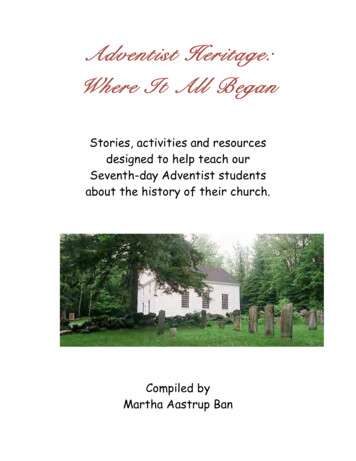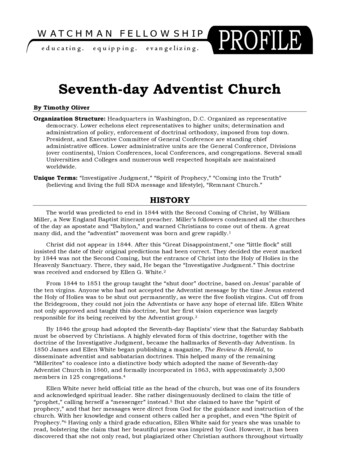
Transcription
Seventh-day Adventist ChurchBy Timothy OliverOrganization Structure: Headquarters in Washington, D.C. Organized as representativedemocracy. Lower echelons elect representatives to higher units; determination andadministration of policy, enforcement of doctrinal orthodoxy, imposed from top down.President, and Executive Committee of General Conference are standing chiefadministrative offices. Lower administrative units are the General Conference, Divisions(over continents), Union Conferences, local Conferences, and congregations. Several smallUniversities and Colleges and numerous well respected hospitals are maintainedworldwide.Unique Terms: “Investigative Judgment,” “Spirit of Prophecy,” “Coming into the Truth”(believing and living the full SDA message and lifestyle), “Remnant Church.”HISTORYThe world was predicted to end in 1844 with the Second Coming of Christ, by WilliamMiller, a New England Baptist itinerant preacher. Miller’s followers condemned all the churchesof the day as apostate and “Babylon,” and warned Christians to come out of them. A greatmany did, and the “adventist” movement was born and grew rapidly.1Christ did not appear in 1844. After this “Great Disappointment,” one “little flock” stillinsisted the date of their original predictions had been correct. They decided the event markedby 1844 was not the Second Coming, but the entrance of Christ into the Holy of Holies in theHeavenly Sanctuary. There, they said, He began the “Investigative Judgment.” This doctrinewas received and endorsed by Ellen G. White.2From 1844 to 1851 the group taught the “shut door” doctrine, based on Jesus’ parable ofthe ten virgins. Anyone who had not accepted the Adventist message by the time Jesus enteredthe Holy of Holies was to be shut out permanently, as were the five foolish virgins. Cut off fromthe Bridegroom, they could not join the Adventists or have any hope of eternal life. Ellen Whitenot only approved and taught this doctrine, but her first vision experience was largelyresponsible for its being received by the Adventist group.3By 1846 the group had adopted the Seventh-day Baptists’ view that the Saturday Sabbathmust be observed by Christians. A highly elevated form of this doctrine, together with thedoctrine of the Investigative Judgment, became the hallmarks of Seventh-day Adventism. In1850 James and Ellen White began publishing a magazine, The Review & Herald, todisseminate adventist and sabbatarian doctrines. This helped many of the remaining“Millerites” to coalesce into a distinctive body which adopted the name of Seventh-dayAdventist Church in 1860, and formally incorporated in 1863, with approximately 3,500members in 125 congregations.4Ellen White never held official title as the head of the church, but was one of its foundersand acknowledged spiritual leader. She rather disingenuously declined to claim the title of“prophet,” calling herself a “messenger” instead.5 But she claimed to have the “spirit ofprophecy,” and that her messages were direct from God for the guidance and instruction of thechurch. With her knowledge and consent others called her a prophet, and even “the Spirit ofProphecy.”6 Having only a third grade education, Ellen White said for years she was unable toread, bolstering the claim that her beautiful prose was inspired by God. However, it has beendiscovered that she not only read, but plagiarized other Christian authors throughout virtually
THE BEST RESOURCE COLLECTION ON CULTS AND RELIGIONSThe Watchman Fellowship ProfileNotebook provides you with an extensive personal library of information about cults, new and alternative religions, world religions, andreligious leaders. You will have atyour fingertips over twenty years ofresearch to answer your questions,strengthen your faith, and improveyour witness to others. Over 100 ProfilesOver 400 pages of informationThe history and primary teachings ofeach groupA Christian responseto deepen your faithand enhance your outreachClick here to order your copy of the watchman fellowship profile notebookBe sure to also order your free subscription to the Watchman Fellowship Profile. Several timeseach year you will receive a new, four-page Profile that you can add to your Profile Notebook, aswell as the latest news from Watchman Fellowship. Click here to order your free subscription!
Seventh-day Adventist Church, page 2all her writings. The sad facts of this matter have been thoroughly and indisputably establishedin several books.7 Ellen White died in 1915 at age eighty-eight.Historically, evangelicals have had difficulty defining and categorizing SDA. Much SDAdoctrine is biblically orthodox. Within its ranks are many true Christians, some even inpositions of prominence. At various points in its history, most notably in the 1888 GeneralConference, the SDA church has been shaken by the biblical gospel. In the 1970s this becamequite intense.8 Unfortunately, it produced a polarization. The church administrators generallybecame more entrenched in the unorthodox positions of traditional SDA, while some pastorsand even whole congregations left or were asked to leave the SDA church.9 In officialpublications the SDA church continues to defend Ellen White legends, and maintain there wasno difference in the degree of inspiration she received from that received by Bible writers.10 Intheir June, 2000, General Conference they voted to more aggressively affirm and support the“Spirit of Prophecy through the ministry of Ellen White.”11 They also teach a number of otherdoctrines clearly irreconcilable with the biblical gospel (see “Doctrine,” below). So long as thesethings continue, evangelicals must persist in questioning the status of the SDA churchorganization in Christianity, and much more, her claim to be God’s only true, end-time“Remnant Church.”DOCTRINESDA teachings most clearly contrary to the gospel and unorthodox in nature are itsinsistence on water baptism as an essential prerequisite to salvation, its teaching about theend time significance of sabbath observance to identification of true believers, and its doctrineof the Investigative Judgment.Baptism: “ Christ made it clear that He required baptism of those who wished to becomepart of his church, His spiritual kingdom.” “In baptism believers enter into the passionexperience of our Lord.” “ [B]aptism also marks [a] person’s entrance into Christ’s spiritualkingdom. it unites the new believer to Christ. Through baptism the Lord adds the newdisciples to the body of believers — His body, the church. Then they are members of God’sfamily.”12The Sabbath: “ [T]he divine institution of the Sabbath is to be restored The delivering ofthis message will precipitate a conflict that will involve the whole world. The central issue willbe obedience to God’s law and the observance of the Sabbath. Those who reject it willeventually receive the mark of the beast.”13In one of her most revered works, Ellen White wrote that Sabbath observance would be the“line of distinction” in the “final test” that will separate God’s end-time people who “receive theseal of God” and are saved, from those who “receive the mark of the beast.”14Describing a supposed vision direct from God, Ellen White wrote, “I saw that the HolySabbath is, and will be, the separating wall between the true Israel of God and unbelievers.”15She also wrote of some Adventists failing to understand that “Sabbath observance was ofsufficient importance to draw a line between the people of God and unbelievers.”16The Investigative Judgment:In 1844 [Christ] entered the second and last phase of His atoning ministry. It is a work ofinvestigative judgment which is part of the ultimate disposition of all sin It also makesmanifest who among the living are abiding in Christ, keeping the commandments of Godand the faith of Jesus, and in Him, therefore, are ready for translation into His everlastingkingdom. This judgment vindicates the justice of God in saving those who believe in Jesus.It declares that those who have remained loyal to God shall receive the kingdom.17 [O]ur High Priest enters the holy of holies [in 1844] to perform the work of investigativejudgment and to make an atonement for all who are shown to be entitled to its benefits Every man’s work passes in review before God and is registered for faithfulness orunfaithfulness The law of God is the standard by which the characters and the lives ofmen will be tested in the judgment As the books of record are opened in the judgment,the lives of all those who have believed on Jesus come in review before God Names are
Seventh-day Adventist Church, page 3accepted, names rejected as they have become partakers of the righteousness of Christ,and their characters are found to be in harmony with the law of God, their sins will beblotted out, and they themselves will be accounted worthy of eternal life Jesus does notexcuse their sins, but shows their penitence and faith, and, claiming for them forgiveness,He lifts His wounded hands before the Father Sins that have not been repented of andforsaken will not be pardoned and blotted out of the books of record, but will stand towitness against the sinner [Christ] had kept His Father’s commandments, and there wasno sin in Him this is the condition in which those must be found who shall stand in the timeof trouble.18According to Ellen White one must believe this doctrine to be saved.Those who would share the benefits of the Savior’s mediation should permit nothing tointerfere with their duty to perfect holiness in the fear of God The subject of thesanctuary and the investigative judgment should be clearly understood by the people ofGod. All need a knowledge for themselves of the position [in the Holy of Holies] and work[investigative judgment] of their great High Priest. Otherwise it will be impossible for them toexercise the faith which is essential at this time or to occupy the position which God designsfor them to fill. Every individual has a soul to save or to lose. Each has a case pending atthe bar of God All who have received the light on these subjects are to bear testimony ofthe great truths which God has committed to them. The sanctuary in heaven is the verycenter of Christ’s work in behalf of men It is of the utmost importance that all shouldthoroughly investigate these subjects The intercession of Christ in man’s behalf in thesanctuary above is as essential to the plan of salvation as was His death upon a cross. ByHis death He began that work which after his resurrection He ascended to complete inHeaven.19Other distinctive SDA teachings include vegetarianism and other “health” issues; thedoctrine of “soul sleep,” a misnomer for the belief that between death and resurrection one isessentially non-existent except in the memory of God; the annihilation of the wicked (asopposed to conscious torment for eternity).BIBLICAL RESPONSEBaptism: (Rom. 3:21–26, 28; 4:4–6, 23–24; 5:1; Gal. 2:16; 3:26; 5:1–6; Eph. 2:4–10; Col.1:13–14; 2:13–14). These passages make it clear that salvation is entirely by God’s grace alone,apart from any works, and laid hold of by faith alone. Baptism is mentioned in close proximityto some of these passages, but the New Testament uses the word baptism in various ways.Clearly, the “one baptism” (Eph. 4:4–5) that is essential is the baptism of the Spirit. If apassage makes baptism essential to salvation it can only refer to the baptism of the Spirit, or itwould conflict with other Scriptures which plainly teach salvation is apart from any humanwork.The Sabbath: The quoted statements above, particularly Ellen White’s, are crystal clear.Sabbath observance, not trust in Christ alone for complete forgiveness of sins and eternal life,is to be the dividing line between the saved and the lost in the end time. This is certainlyantithetical to the gospel defined by the passages above. (See also, Rom. 14:5–6; Col. 2:16–17).The Old Testament Sabbath was never anything more than a shadow of the substance. Thereality of the New Testament Sabbath rest of God, which Paul and the writer of Hebrews makeclear, is Christ Himself, and the rest one experiences from one’s own works when one entersinto Christ (Heb. 4:1–10).The Investigative Judgment: the whole concept of the investigative judgment isantithetical to the Gospel. Jesus did not wait until 1844 to enter the Holy of Holies in heaven(Heb. 1:3; 6:19–20; 8:1; 9:6–12, 24; 12:2). Neither is he still making an atonement in heaven(Heb. 9:25–26; 10:11–14). The investigative judgment proposes to “vindicate the justice of Godin saving those who believe in Jesus,” by showing they were “loyal,” “penitent,” and “faithful”commandment keepers. This is an outrage. God’s justice in saving sinners is vindicated byChrist’s death on the cross, period (Rom. 3:24–26).
Seventh-day Adventist Church, page 4Even when speaking of being saved by the righteousness of Christ, Adventist writers referto imparted righteousness, seldom to the biblical concept of imputed righteousness. Calling it“Christ’s righteousness,” while insisting on the believer’s perfection of character as aprerequisite to salvation, is at worst a thinly veiled works salvation, or at best an attempt tomix grace and works, something the Bible says is impossible to do (Rom. 11:6). Mrs. Whiteswords are crystal clear—one will not be forgiven until all sins are eradicated from one’s life andone’s character is perfected. Precisely the same heresy is found (besides many others) inMormonism. It is not the salvation by grace alone through faith alone offered in the Bible.The error is compounded by the teaching that this latter day 1844 event must be believedin to exercise the proper faith necessary to be saved. When Jesus said on the cross, “It isfinished,” i.e. completed, paid in full, it cannot be that there is yet another salvation event morethan 1800 years later, just as essential to salvation as Christ’s death on the cross, in whichone must believe in order to be saved. This is clearly “another gospel” (Gal. 1:6–9).Other doctrines: Some of the SDA health message may actually be helpful, and it doesnot conflict with the gospel except when, as is often the case, spiritual stigma is attached tonon-observance of its asceticism (Gal. 2:11-16). The soul-sleep doctrine conflicts with thegospel because, closely examined and fully understood, it actually constitutes a denial of theresurrection (though it is doubtful any SDA understands it to be so). Notwithstanding asmattering of “proof-texts,” the annihilation doctrine is definitely aberrant from the teaching ofthe Bible. It leaves the sinner facing no eternal consequences for his sin; angst overannihilation will not survive annihilation. Indeed, many people today think annihilationpreferable to even this life. They live on only because they cannot shake the conviction thatthere is “hell to pay.” God has set eternity in their hearts (Eccl. 3:11).RECOMMENDED READINGThe Sabbath in Crisis by Dale Ratzlaff. Excellent book by a former SDA pastor, coversvirtually every aspect of the Sabbath question. 345 pages, include. scripture index.The Cultic Doctrine of Seventh-day Adventists by Dale Ratzlaff. Probably the best popular,overall, treatment of Seventh-day Adventism, and especially the 1844/InvestigativeJudgment/Sanctuary doctrine, ever penned. Leaves no doubt. 384 pages, four appendices,incl. bibliography.Sunday Facts and Sabbath by Dr. Russell K. Tardo. Presents 25 Reasons Why theChristian Church Worships on Sunday. 144 pages.NotesMelton, J. Gordon, Encyclopedia of American Religions, Vol. 2, 21–22.2 Ibid., 680.3 Robert D. Brinsmead, Robert, Judged by the Gospel: A Review of Adventism, 130–33.4 Encyclopedia of American Religion, Vol. 2, 681.5 P. G. Damsteegt et. al., Seventh-day Adventists Believe. . ., 224.6 Maurice Barnett, Ellen G. White & Inspiration, 5–17.7 e.g., see; Walter Rea, The White Lie; and Judged by the Gospel, 361–83.8 Se: Geoffrey J. Paxton, The Shaking of Adventism.9 “From Controversy to Crisis,” CRI Journal, Vol. 11, No. 1, 9–14.10 Review & Herald, 4 October 1928, 11; “Source of Final Appeal,” Adventist Review, 3 June 1971, 4–6; G. A. Irwin, Mark of the Beast, 1;“The Inspiration and Authority of the Ellen G. White Writings,” Adventist Review, 15 July 1982, 3; Ministry, October 1981, 8; see also,Judged by the Gospel, 125–30.11 Adventist Today, [online: July 2000].12 SDA’s Believe , 182, 184, 187.13 Ibid., 262–63.14 The Great Controversy Between Christ and Satan, 605.15 Early Writings, 33; emphasis added.16 Ibid., 85.17 SDA’s Believe , 312; emphasis added.18 Great Controversy, 480, 482–84, 486, 623.19 Ibid., 488–89; emphasis added.1Profile is a regular publication of Watchman Fellowship, Inc. Readers are encouraged to begin their ownreligious research notebooks using these articles. Profiles are published by Watchman Fellowshipapproximately 6 times per year, covering subjects such as new religious movements, counterfeitChristianity, the occult, New Age Spirituality, and related doctrines and practices. Complete ProfileNotebooks containing all Profiles published to date are available. Please contact Watchman Fellowshipfor current pricing and availability. All rights reserved 2000.
responsible for its being received by the Adventist group.3 By 1846 the group had adopted the Seventh-day Baptists’ view that the Saturday Sabbath must be observed by Christians. A highly elevated form of this doctrine, together with the doctrine of the Investigative Judgment, became the hallmarks of
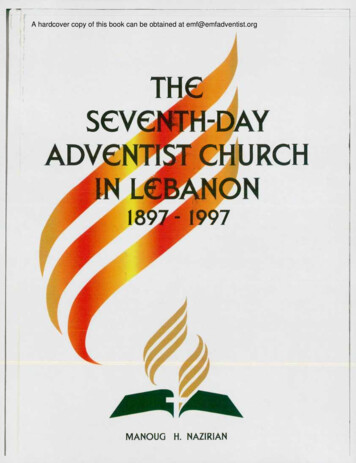

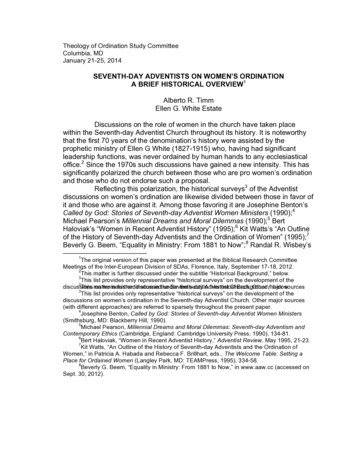
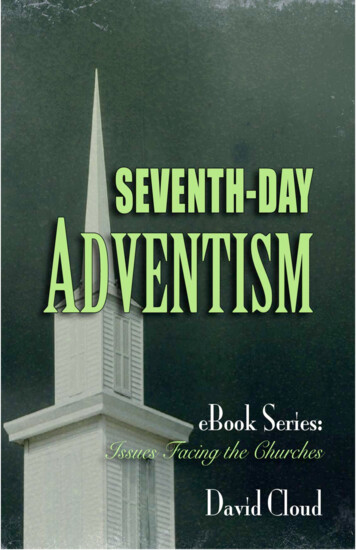
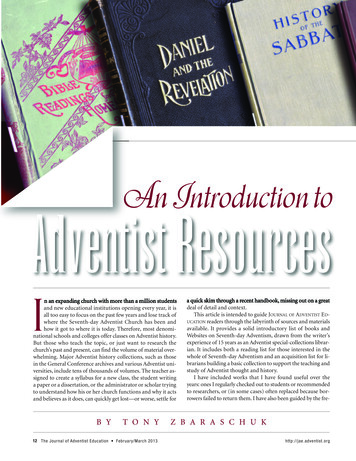
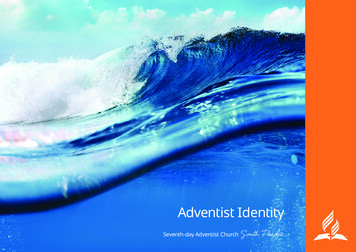
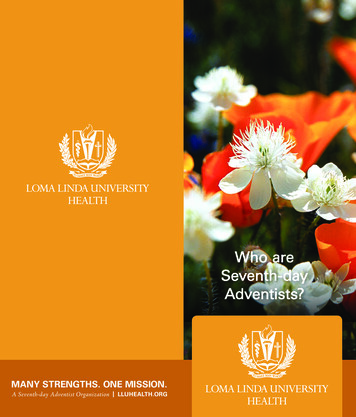

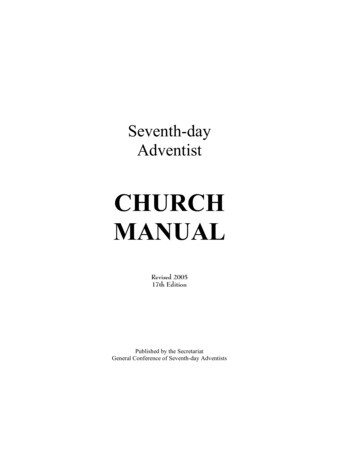
![Welcome [dashdiet.me]](/img/17/30-day-weight-loss-journal.jpg)
